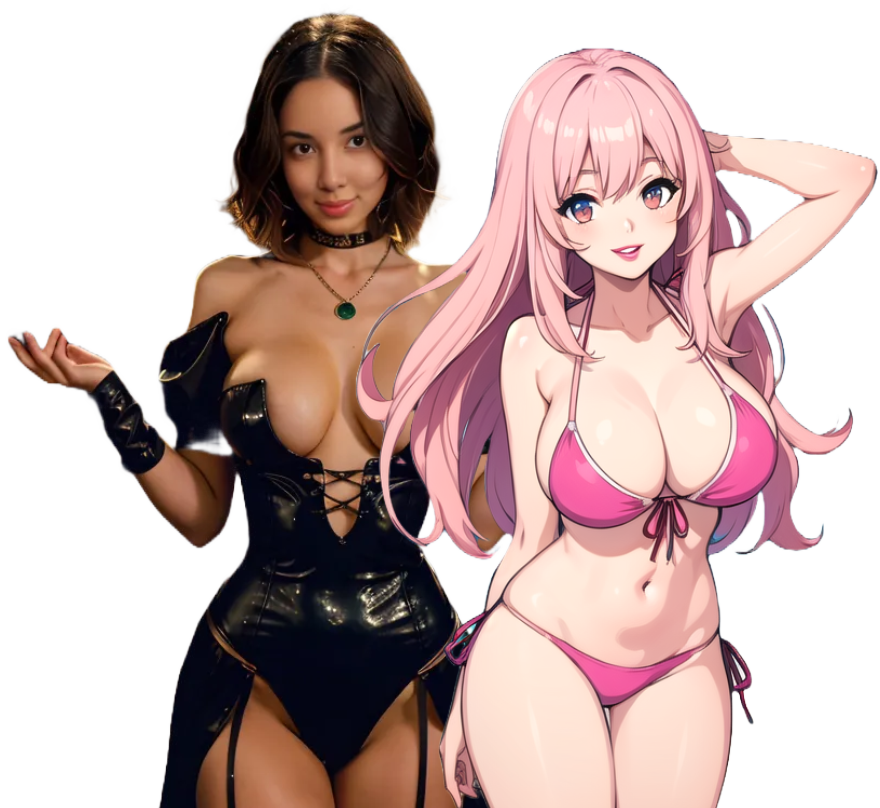Create Your Own AI Girlfriend 😈
Chat with AI Luvr's today or make your own! Receive images, audio messages, and much more! 🔥
4.5 stars
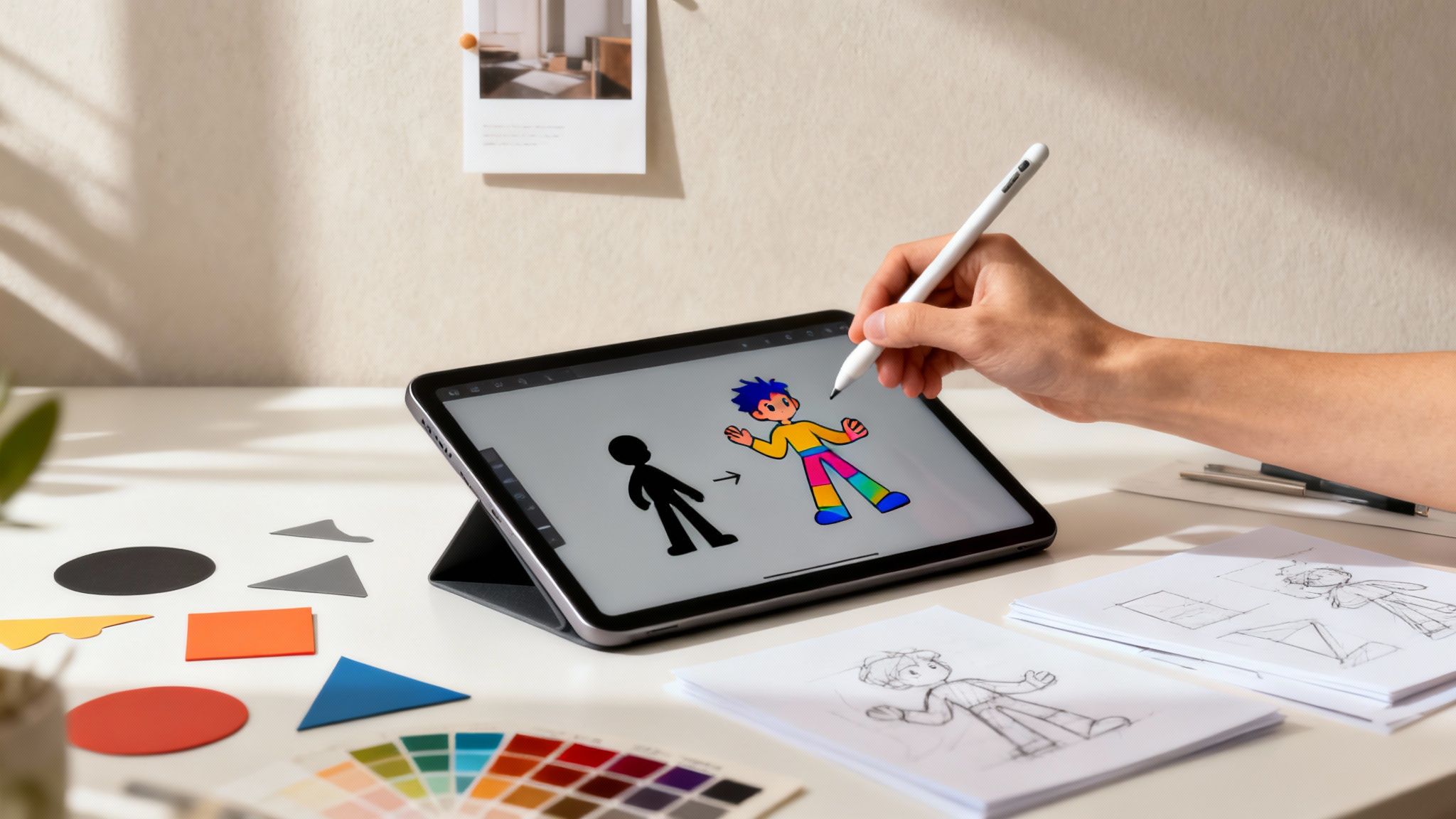
Character design is so much more than just sketching a cool-looking figure.It's a delicate dance between psychology, storytelling, and visual communication. Every line, color, and shape you choose is a decision that breathes life into a personality, making them feel real enough to step off the page.
The Core Principles of Unforgettable Characters
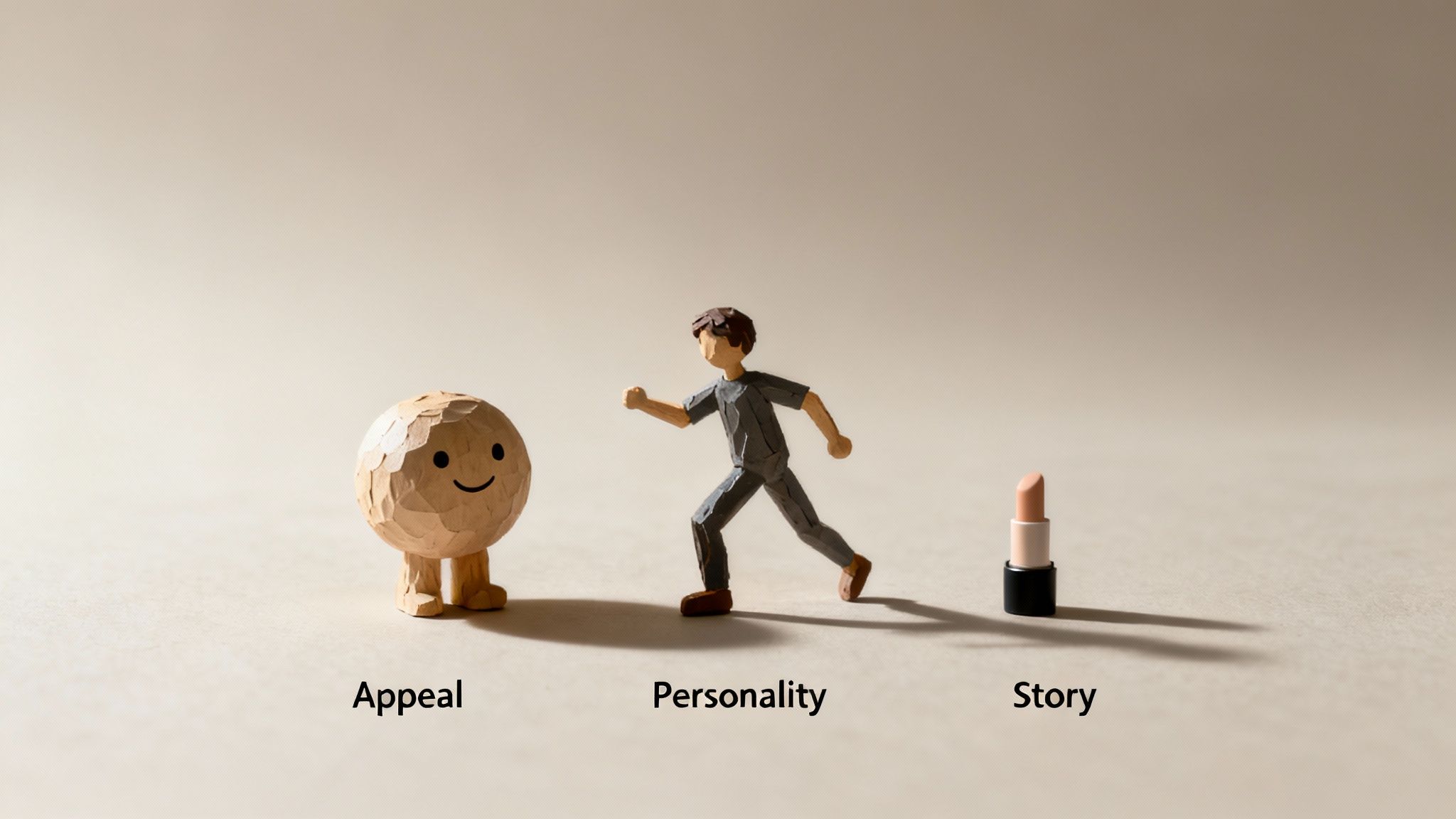
So, you want to create characters that stick with people long after they've seen them? You're in the right place. We're going to break down the essential ingredients that separate a forgettable doodle from a legendary icon. This isn't about dry, academic theory; it's about the magic that happens when art meets human connection.
At the very heart of it, every great character is built on a simple but powerful triad: Appeal, Personality, and Story. Think of it like a three-legged stool. If one leg is weak or missing, the whole thing topples over. All three elements have to work together, supporting each other to create something that feels complete and compelling.
Understanding the Foundational Triad
To really get good at this, you have to feel how these three pillars lean on one another. A gorgeous design without a personality is just an empty shell. A character with a deep, tragic backstory is wasted if no one finds them interesting enough to look at in the first place.
Appeal: This is a widely misunderstood concept. Appeal isn't just about being "pretty" or "cute." It's about creating a design that is visually engaging and makes you want to look at it. A grotesque monster or a menacing villain can have just as much appeal as a heroic protagonist if their design is interesting and well-executed.
Personality: This is the soul of your character. It’s their motivations, fears, quirks, and how they see the world. A well-defined personality informs everything—from how they stand and gesture to the expressions that flash across their face.
Story: Characters don't just pop into existence. Their history, their world, and their place in the narrative define who they are. That scar above their eye? It came from a past battle. Those worn-out boots? They hint at a long, hard journey. These details make them believable.
Here's a classic test of great design: can you recognize a character from their silhouette alone? The most iconic figures are instantly identifiable because their shapes communicate everything you need to know at a single glance.
This guide is your roadmap. It'll give you the tools and the mindset to create characters that truly connect, whether you're designing for a comic book, a video game, or even the new wave of immersive AI companions. For a shot of inspiration, it's always a good idea to see what others are creating. Exploring a diverse library of pre-made AI characters can show you just how varied and compelling these creations can be.
2. Visual Design Principles That Animate Your Ideas
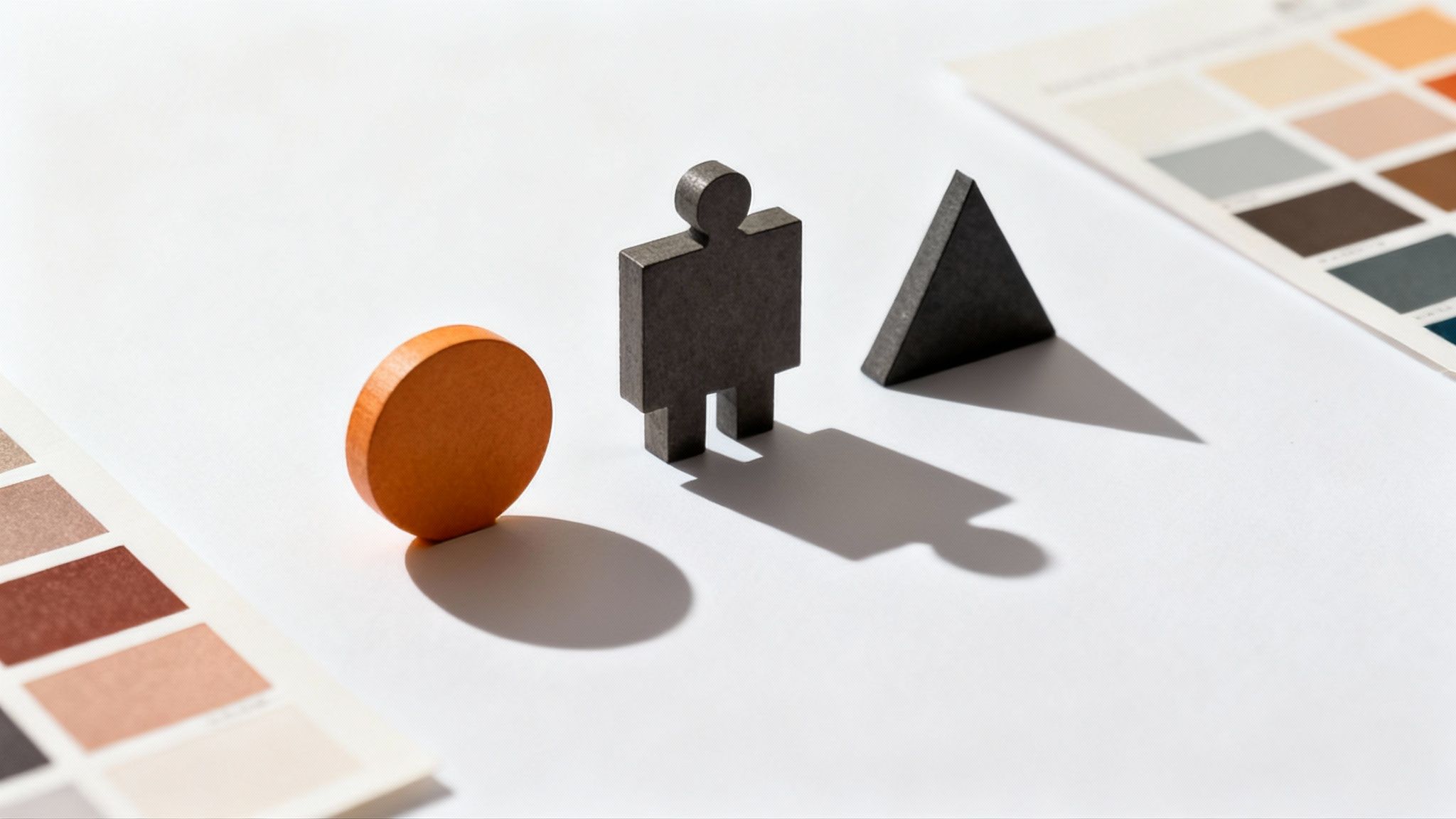
Before a single word is spoken, before your character even moves, your audience has already made up their mind about them. That first visual impression is everything. It's an instant handshake between your creation and the viewer, and it’s where the foundational principles of great character design really shine.
These aren't just stuffy, academic rules; they're a visual language that everyone instinctively understands. A strong design doesn’t just look cool—it tells you exactly who this character is in a single glance. Let’s break down the three pillars that will make sure your characters leave a lasting mark: shape language, color theory, and the non-negotiable power of the silhouette.
The Power of Shape Language
Our brains are hardwired to connect shapes with feelings. It's a mental shortcut, and it's one of the most potent tools in your design arsenal. When you build a character around a dominant shape, you’re embedding their personality directly into the viewer’s subconscious.
Let's look at the big three:
- Squares: Think sturdy, stable, and dependable. Characters built on squares and rectangles often feel grounded, stubborn, or incredibly strong. They're your stoic warriors, your unshakeable protectors, or that grumpy but reliable father figure.
- Circles: Soft, friendly, and approachable. Circles and ovals communicate warmth, safety, and innocence. This is the go-to shape for kind-hearted heroes, adorable sidekicks, and anyone you want the audience to trust instantly.
- Triangles: These are dynamic, sharp, and can signal danger. The pointed edges suggest speed, cunning, and aggression. It's no wonder triangles are so often used for villains, mischievous tricksters, and fast-moving heroes.
We can see this "shape language" everywhere in character design. It's a quick, unspoken way to telegraph a character's core nature.
The Power of Shape Language in Design
| Shape | Associated Traits | Common Archetypes |
|---|---|---|
| Square | Stability, strength, reliability, stubbornness | The Hero, The Guardian, The Grunt |
| Circle | Friendliness, safety, innocence, warmth | The Sidekick, The Innocent, The Caregiver |
| Triangle | Danger, speed, cunning, aggression | The Villain, The Trickster, The Rebel |
By deliberately choosing a primary shape, you lay a powerful foundation that makes every other design choice feel more intentional and cohesive.
A character's design is the visual summary of their personality. If their appearance and their inner self are in conflict, the audience will feel that disconnect. True character design mastery is about aligning every visual choice with the character's core identity.
The Undeniable Impact of Color
Color is pure emotion. It’s a direct line to the audience’s feelings, capable of setting the mood and defining a character before they've even taken a step. A smart color palette can communicate personality, group loyalties, and even the entire tone of your story.
You don't need a rainbow of colors to make an impact. In fact, a simple, focused palette is almost always more effective. Too many colors create visual noise and muddy your character's identity. Instead, pick one dominant color that represents their core trait and add one or two accent colors for contrast and depth. A heroic character might be built on primary blue (trust, stability) with a splash of red (action, passion).
Think back to the most iconic characters. In 1928, Walt Disney's team created Mickey Mouse using bold lines, simple shapes, and a stark silhouette—a figure that remains instantly recognizable nearly a century later. The principles they used are still central to character design today. You can learn more about the fascinating history of character animation and its innovations to see how these fundamentals evolved.
Why the Silhouette Is Everything
Here’s the ultimate test of your design: if you strip away all the color, texture, and internal details, leaving only a black outline, is your character still recognizable?
That's the silhouette test, and it’s the final boss of character design.
A strong, clear silhouette ensures your character stands out in any situation—in a chaotic action scene, from a distance, or in a crowded room. It forces you to focus on their fundamental shape and posture, which are the bedrock of visual storytelling. A unique silhouette is what burns a character's image into our collective memory. It’s what separates a good design from a legendary one.
2. Give Your Character a Soul: Personality and Backstory
If a strong visual design is your character's body, then personality and backstory are its soul. A stunning drawing without a compelling inner world is just a pretty, empty shell. This is where we go deeper than appearances and get into what makes a character feel real and worth caring about.
Your audience has to believe your character had a life long before they showed up in the story. That hidden history—full of wins, losses, and quiet little moments—is what shapes who they are right now. It’s what informs their posture, the look in their eyes, and why they make the choices they do.
The Character Diamond: Four Points to Define a Personality
It’s easy to fall down the rabbit hole of writing a massive biography that nobody will ever actually read. Instead of a novel, aim for clarity and impact. A fantastic tool for this is the "character diamond," a simple method for locking in four core traits that anchor your character's personality.
These four points are the essence of who they are, and they often create fascinating internal conflicts.
For example, a character might be:
- Brave: They run toward danger to protect others, no questions asked.
- Impulsive: But that bravery often means they leap before they look.
- Loyal: They would do anything for the people they consider family.
- Cynical: Yet, despite that deep loyalty, they find it almost impossible to trust outsiders.
See the friction there? This diamond creates a dynamic, believable person, not a flat, predictable archetype. Their bravery is complicated by their impulsiveness, and their loyalty is tested by their cynicism. That internal tug-of-war is what makes them interesting.
A character's backstory isn't just for writers; it's a blueprint for designers. A history of hard labor might show up as calloused hands and a sturdy build. A past trauma could translate into guarded body language and averted eyes. Every visual choice should be an echo of their story.
Turning Backstory into Visual Clues
A backstory is useless if it just sits on a document somewhere. Its real job is to drive your design choices and make the character feel authentic. You don’t need to map out every single day of their life—just focus on the moments that left a mark.
Ask yourself a few powerful questions to build a story that works for you:
- What’s their greatest achievement? This tells you about their confidence and pride. Maybe it shows up as a proud stance or a tarnished medal they refuse to take off.
- What’s their deepest regret? This is the source of their vulnerability. It could be a physical scar from a mistake, a nervous tic, or a constant shadow of sadness in their eyes.
- Who is the most important person in their life? This relationship defines their capacity for love, loyalty, or even hate. A simple locket or a worn-out letter can say more than a thousand words.
- What does their environment say about them? Did they grow up in a grimy, industrial city or a peaceful, green forest? This directly influences their clothes, their skills, and even their color palette.
The answers give you tangible visual hooks. Someone from a wealthy family might wear pristine, tailored clothing, while a survivor of a harsh wasteland would be decked out in patched-up, practical gear. Their story is written all over them.
Making Inner Worlds Interactive
This kind of deep, layered personality is precisely what makes modern AI companions feel so alive. When a character has a well-defined inner world, their responses become more consistent, surprising, and human. Suddenly, you're not just chatting with a program; you're connecting with a personality shaped by a rich history of (simulated) experiences.
This is the magic behind platforms that let you build relationships with AI. When you dive into a compelling AI character chat, you're seeing these design principles in action. Their quirks, memories, and reactions all spring from the same kind of foundational work we've been talking about.
By giving your characters a soul, you don't just make them better designs—you make them unforgettable.
How Professionals Navigate the Design Workflow
Iconic characters rarely spring to life in a single flash of genius. If you peel back the curtain, you’ll find that professional designers rely on a structured, deliberate workflow to turn a vague idea into a polished, compelling final product. This process isn't about killing creativity—it's about building a solid foundation so your best ideas can truly shine.
Think of it like a sculptor staring at a block of marble. They don't just grab a chisel and start hacking away at the details. They study the stone, sketch the form, and make broad, strategic cuts long before they get to the finer points. That's what a professional workflow does: it brings purpose and consistency to the creative journey.
The Crucial Research and Discovery Phase
Every great character design starts not with a pencil, but with curiosity. Before a single line is ever drawn, the pros dive deep into research, gathering the raw materials that will build the character's world and personality. This means creating mood boards, studying cultural aesthetics, and getting to the heart of the story's themes.
This initial deep dive is non-negotiable if you want to create something authentic. Designing a space marine from a rigid, militaristic society? Your research should cover everything from real-world military uniforms and sci-fi armor concepts to symbols of authority. This groundwork is what makes a design feel grounded and believable instead of generic.
Ideation and the Power of Thumbnails
Once you've got a solid base of research, it's time to get messy. The goal is to explore as many ideas as possible, as quickly as possible. This is the ideation phase, and it’s where designers crank out dozens of small, rough sketches called thumbnails.
Don't mistake this for a drawing contest. Thumbnails are about quantity over quality. You're exploring silhouettes, shapes, and core concepts without getting bogged down in the tiny details. By churning out a high volume of ideas, you give yourself the freedom to stumble upon unexpected solutions and avoid marrying the first concept that pops into your head. It's basically a brainstorming session on paper.
Key Takeaway: The professional process is built on iteration. Your first idea is rarely your best. True innovation comes from exploring multiple paths, combining the strongest elements, and refining them based on clear goals and constructive feedback.
The character design process has become remarkably structured for a reason. Industry surveys reveal that over 75% of professional designers follow a multi-stage workflow, often spending 20-30 hours on research alone for major projects. It’s a powerful reminder that discipline is just as critical as raw talent. You can get more insights on this structured design process and its impact on the industry.
From Sketching to Final Refinement
After picking a winning thumbnail, the real work of refinement begins. This is where you’ll create more detailed sketches, play with different costumes and features, and explore color palettes. It's also where collaboration becomes essential—art directors, clients, and teammates all weigh in, helping to push the design toward its full potential.
This infographic does a great job of showing how a character's core elements—backstory, traits, and visual design—are built upon one another in a logical flow.
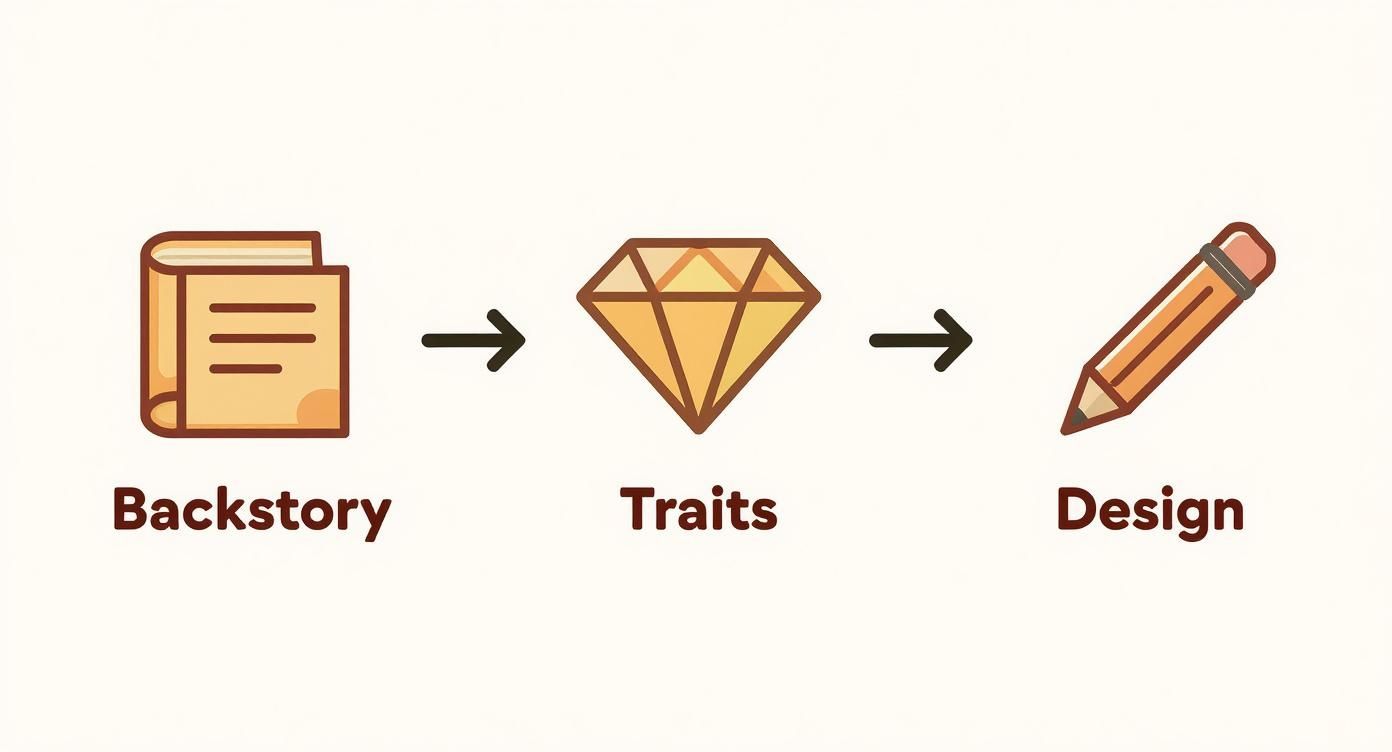
As you can see, a compelling design is the final expression of a deeply considered backstory and a clear set of personality traits. It's the tip of the iceberg.
The final stage, refinement, is where the magic happens and the character truly comes to life. Linework is cleaned up, colors are locked in, and every last detail is polished to perfection. This last step ensures the character is ready for animation, illustration, or whatever comes next, completing the journey from a simple thought to a fully realized personality.
Adapting Your Designs for Different Media
A character isn't a static blueprint you can just copy and paste everywhere. The same whimsical design that shines in a children’s picture book will probably feel completely out of place in a gritty, realistic video game. This is where the real craft comes in: adapting your design to fit the world it's going to live in.
Think of it this way: every medium—animation, video games, comics—has its own language, its own rules, and its own audience. A character meant for a tiny mobile game screen needs to be bold and instantly recognizable. One destined for a 3D animated film has to look good and feel right from every possible angle. If you ignore these constraints, you don't just get a bad design; you get a character that feels like an awkward guest at the wrong party.
Designing for 2D Animation vs. 3D Film
Jumping from 2D to 3D is a massive leap. It’s not just about adding another dimension; it changes how you have to think about the character from the ground up.
In traditional 2D animation, you can get away with a few clever tricks. An intricate pattern on a shirt? You can simplify it in action shots to save time and effort. It’s all about nailing strong, clear poses and expressive lines that tell the story from a specific camera view.
But 3D? There’s nowhere to hide. That character has to be a fully-realized, 360-degree creation. Every detail matters—the way their hair moves, the wrinkles in their clothes, the texture of their skin—because the camera can, and will, see it all.
- 2D Animation: The priority is a powerful silhouette, expressive lines, and a design that’s practical to redraw over and over again.
- 3D Film: You're building a digital puppet. The design needs to have volume, work from all angles, and be built for complex movement and texturing.
A great 3D character isn't just born from a concept artist's sketch; it's a deep collaboration with the rigging team who has to make it move believably.
Technical Constraints in Video Games
Video games throw a whole different set of challenges into the mix. Unlike a film where everything is rendered out beforehand, game characters have to be drawn by the computer in real-time, 60 times a second. Every single part of your design has a performance "cost."
The big one is the polygon count—the number of little flat shapes that build your 3D model. More polygons mean more detail, but they also demand more from the hardware. A designer has to be a budget manager, putting detail where it counts (like the face and hands) and simplifying in less important areas. The whole history of video game art is a story of artists fighting against these limits. Think about the original Super Mario; he was blocky and simple because he had to be, but those limitations forced a design that was iconic even at a tiny size. You can see this evolution clearly in the timeline of character design in gaming—it's a direct reflection of technology getting more powerful.
Every design choice in a game is a trade-off between artistic vision and technical reality. A gorgeous character that makes the game stutter and lag is, functionally, a failed design.
Tailoring Designs for Specific Audiences
Beyond all the technical stuff, the single most important factor is who you’re designing for. You have to speak the visual language of your audience.
Designing for kids? You’ll likely lean into bright colors, soft, rounded shapes, and big, expressive features. It’s a direct and simple way to communicate emotion.
Creating a character for a more mature audience? You can play with subtlety, more complex color schemes, and realistic proportions. It's all about communication. You’re sending a visual message, and if you don't use a language your audience understands, it'll just be noise. Ignoring genre conventions or cultural tastes is a surefire way to have your work fall flat, which is why knowing your audience is a cornerstone of great character design.
Using AI to Spark Character Concepts and Ideas
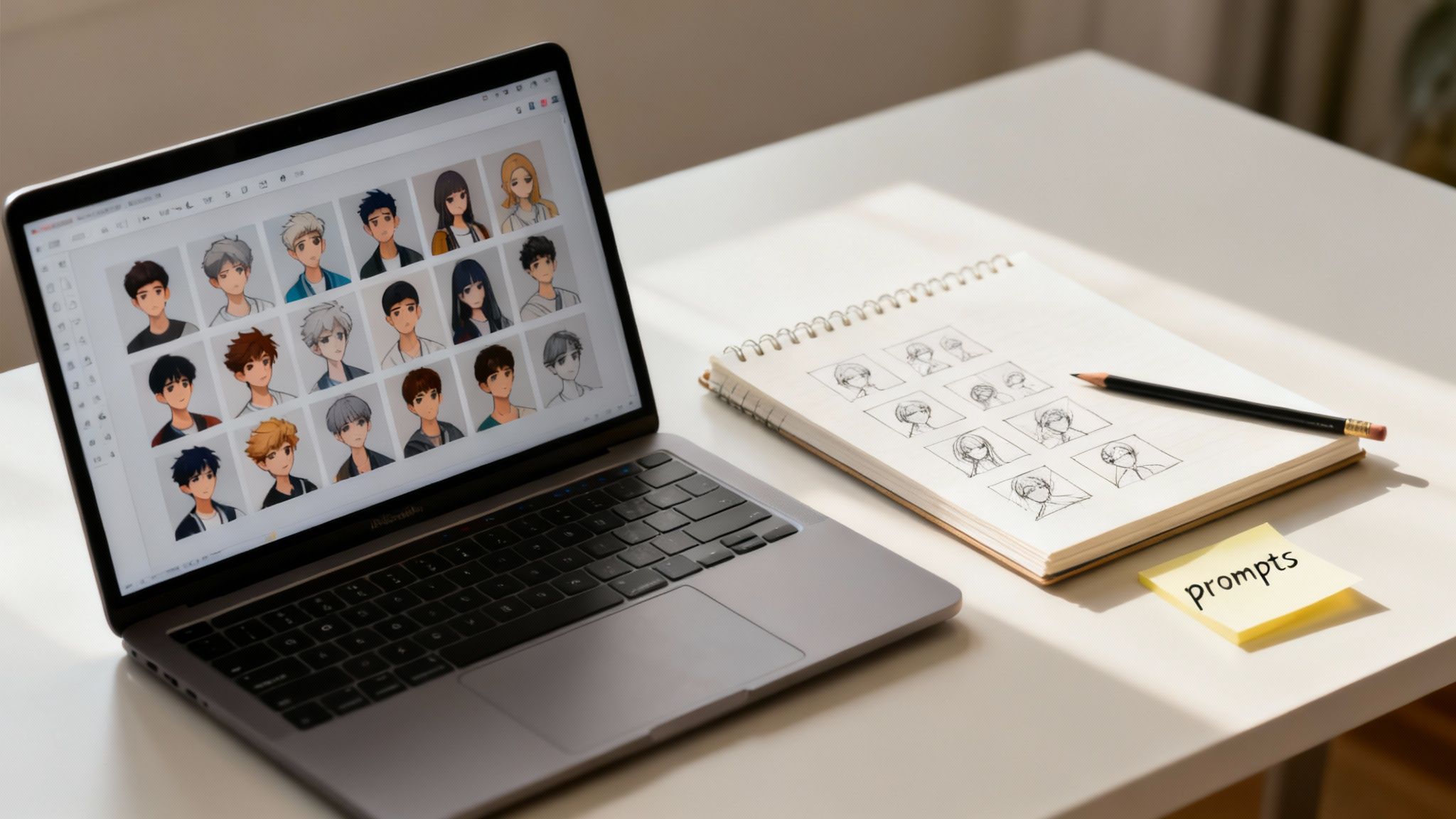
The future of character design isn't about artists being replaced by machines. It's about collaboration. Think of AI as your new creative co-pilot—a tireless brainstorming partner that helps you shatter creative blocks and explore visual territories you never thought possible, and in record time.
This isn't about letting a program do the work for you. It's about enhancing your own skills. AI is brilliant at generating dozens of variations on a theme, letting you test-drive wild costume ideas, or play with unique visual styles that would have taken days to sketch by hand. The core character design fundamentals are still your job to master; AI just gives you an incredibly powerful new tool to work with.
Mastering the Art of the AI Prompt
The real magic behind using AI for design comes down to how you talk to it. In other words, you have to get good at writing prompts. A vague request like "design a warrior" is going to get you a bland, forgettable result every single time. A detailed, layered prompt, however, is like handing your digital assistant a professional creative brief.
To truly guide the AI toward something special, build your prompts with specific layers:
- Archetype and Role: Start with the core identity. Are they a "stoic guardian," a "mischievous rogue," or a "wise old mentor"?
- Visual Style: Nail down the artistic vibe. Try phrases like "in the style of classic '90s anime," "hyper-realistic dark fantasy art," or even "minimalist vector mascot."
- Key Features and Costume: This is where you add the flavor. Describe the "worn leather armor with intricate silver filigree," "glowing mystical tattoos," or "asymmetrical cyberpunk jacket."
- Mood and Lighting: Set the stage. Words like "dramatic Rembrandt lighting," "soft morning mist," or "neon-drenched cityscape" completely transform the final image's emotional impact.
When you weave these elements together, you stop making simple requests and start giving powerful creative direction. The AI becomes a true extension of your own vision, and that's a game-changing skill for any modern designer.
AI doesn't create in a vacuum. It synthesizes vast amounts of existing art and data. Your role as a designer is to guide that synthesis with your unique vision, curating the results and adding the human touch that makes a character truly special.
From First Idea to Polished Concept
Once the AI spits out a handful of visuals, your real work begins. This is where your trained artist's eye comes in to spot the strongest concepts and start refining them. You might fall in love with the silhouette from one version but prefer the detailed costume from another. Think of the AI's output as a high-quality mood board—a jumping-off point for your own digital painting or kitbashing.
This back-and-forth process is where you'll find the magic. It’s a fluid conversation between your creative gut and the AI’s incredible generative power.
Platforms are making it easier than ever to bridge the gap between a cool idea and a living character. You can now generate a high-fidelity AI character image and immediately use it as the visual anchor for building a deep, interactive personality. This seamless workflow—from a visual spark to an interactive being—is changing the game entirely.
Got Questions? Let's Talk Character Design
As you start bringing your own characters to life, you're bound to hit a few common roadblocks. It happens to everyone. Let's walk through some of the questions I hear most often and get you over those hurdles.
What’s the Single Most Important Part of a Character’s Design?
This is the big one, and you’ll get different answers depending on who you ask. Visually, I'd bet my money on the silhouette. Can you tell who the character is just from their shadow? If the answer is yes, you've created something truly iconic. It’s the ultimate test of a strong, memorable design.
But a great look is only half the battle. From a story perspective, a well-defined personality is everything. A gorgeous design without a soul is just an empty shell. A character with a compelling personality, on the other hand, can capture hearts even with the simplest drawing. The visuals are there to serve the character, not the other way around.
I’m Stuck. How Do I Get Past a Creative Block?
First, breathe. Creative blocks aren't a sign you've failed; they're just part of the process. The best thing you can do is step away from the drawing board and go back to gathering inspiration. Dive into research, build a new mood board, or just go people-watch at a coffee shop.
I also love using creative constraints to shake things up.
- Try designing a character using only three colors.
- See what you can come up with using only triangles or only circles as a base.
Forcing yourself into a box like this makes your brain work differently. It pushes you to find clever solutions you’d never stumble upon otherwise.
Originality isn't about creating something from nothing. It's about remixing your unique influences—history, nature, film, your own life—into a voice that is completely your own. That’s where the magic happens.
How Do I Make Sure My Characters Feel Genuinely Original?
Stop trying to pull ideas out of thin air. The secret is to become a master combiner. Don't just copy one artist you admire; blend your inspirations together. Take the posture of a predator, mix it with the fashion of a specific historical era, and filter it all through the emotional tone of your favorite movie.
Ultimately, the surest path to an original design is to tell a specific, personal story. A character's unique history, their deepest fears, and their wildest dreams will demand a visual design that could only belong to them. Their story is your roadmap.
Ready to create characters that feel truly alive? At Luvr AI, we give you the tools to design and chat with complex AI companions who have their own distinct stories and personalities. Come see what you can build.



